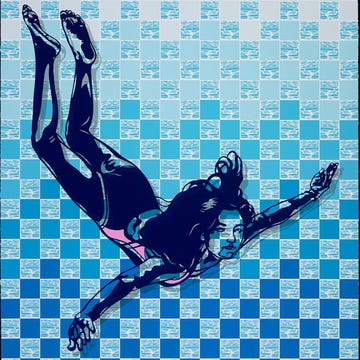In the 2025 documentary Remaining Native, a runner standing near the finish line of the Remembrance Run points to a nearby plot: “What kind of school has a cemetery?” she asks. It’s a good question.
The race, organized by runner Kutoven "Ku" Stevens, is an annual tradition inspired by Stevens’s great-grandfather Frank Quinn, who attempted to escape imprisonment at an Indian boarding school three times before he was eight. On his third effort, in the early 1900s, Quinn ran 50 miles back to his home on the Yerington Paiute reservation. According to a 2022 Department of Interior report, the federal government ran at least 408 federal Indian boarding schools between 1801 and 1969. The schools practiced flogging and solitary confinement of children, among other abuses. Quinn’s story is a testament to Indigenous resilience, memorialized by Stevens more than a century later in the two-day Remembrance Run held in the scorching Nevada desert. Starting at Stevens’s reservation in Yerington and ending at the Stewart Indian School (where Quinn was taken) in Carson City, the run retraces 50 miles of painful history. Haudenosaunee director Paige Bethmann recorded the 2022 run through her lens, capturing the closure the event offers to families such as Stevens’s who had ancestors trapped in government-operated boarding schools.
The 87-minute film grapples with the violent treatment of Indigenous people, namely the federal policies of the late 19th century that ripped children from their homes and replaced their culture. Through interviews with members of the Paiute community, Bethmann depicts the ripple effects of generational trauma. But then, there’s Stevens, whose quiet determination leads a small group of Indigenous runners of all shapes and sizes down a long path, running into their future.
I recently spoke with 21-year-old Stevens, who plans to attend Washington State University in the fall, about his future and the evolution of the documentary.
This interview has been edited for brevity and clarity.
How did you start the Remembrance Run?
At first, the run was just going to be me, my mom, and my dad. But my mom posted about it on Facebook, and people wanted to join. The run became an event.
You wear many hats in the film. How do you see yourself?
At the end of the day, I’m a runner. It’s what I do best.
Where do you get your drive?
Knowing where I come from, knowing just, like, the history of my people. I feel like a lot of people can kind of struggle with their Indigeneity. I found it to be one of my biggest strengths—having kind of the sureness to myself. And that’s really how I carry myself.
Growing up, I had to decide what kind of life I wanted to lead and what kind of beliefs coincide with that. I experienced some disassociation with Native American practices and culture, but I still make time for a lot of different activities and ceremonies.
How did you feel about being the main subject in Remaining Native?
A filmmaker from New York, Paige, reached out through Facebook and asked to film the event. It was very grassroots. We wanted to raise as much awareness as we could, but we didn’t really have the expectation of having a film made about it or it going bigger than newspaper articles. But as things were starting to progress, everything just kind of clicked.
In the film, I noticed that Oglala Lakota Olympic gold medalist runner Billy Mills was at the Remembrance Run.
Mills has an organization called Running Strong for American Indian Youth that gives seed money to Natives with various projects. I was part of their DreamStarter program; they funded the second Remembrance Run. Mills and I have a really special relationship. I cherish it so much.
What’s next for you?
I’m starting at WSU next year. I’m going to run there and plan to get my master’s in art. I’m not sure if I have a pro running career in my future, but I would like to think so. I know people at Nike in the N7 department, which is their collection dedicated to Native-inspired designs. I want to work there as an outreach coordinator to better connect with Indigenous people. I could never afford the N7 shoes.
I just want to be a voice for our people. I plan to get into politics, though I’m not sure when. But whenever I feel the calling, I will go.
On June 3 at 5:30 p.m. Pacific, Stevens and Bethmann will join Alta Journal contributor Bonnie Tsui for a discussion at the Commonwealth Club World Affairs of California.•
Jason Asenap is a Comanche and Muscogee Creek writer, critic, and filmmaker based in Albuquerque, New Mexico.














